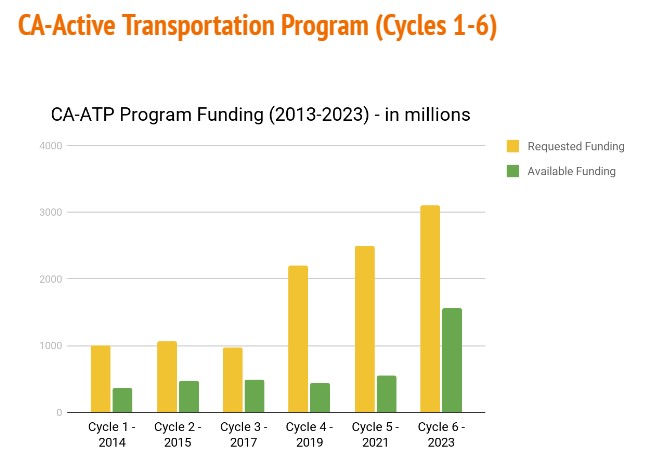It’s been a decade since the California Active Transportation Program (ATP) launched and became the primary source of funding for local pedestrian and bicycle projects in the state. Created in 2013, the ATP combined a number of different funding sources for bicycle, pedestrian, and Safe Routes to School projects into one pot of money. Originally annually and now every two years, the program invites municipalities across the state to request funds to make California more walkable and bikeable. In the first six funding cycles, Los Angeles County’s two largest jurisdictions – the City and County of Los Angeles – have secured over $600 million in CA-ATP funding, $560 million for the City of L.A. and $66 million for the County of Los Angeles.
The funding stream is incredibly important in moving large active transportation projects forward. Even in a “self-help” region like Los Angeles County, where a supermajority of voters supported transportation sales taxes - Measure R in 2008 and Measure M in 2016 - the state Active Transportation Program remains one of the only sources of funding dedicated to walking and bicycling. Why? For one, almost none of the billions of the sales tax funding from LA County’s ballot measures over the past three decades was set aside for active transportation. Only Measure M, passed by County voters in 2016, dedicated any funding for active transportation, and then only a paltry 2% that was reserved entirely for first mile / last mile projects and closing the gap in the Los Angeles River path.

That has left most pedestrian and bike projects entirely reliant on competitive grant funding, the primary source being ATP. So how have L.A. County’s biggest agencies fared in the program’s first ten years? For the three most recent funding cycles (2019-2023), the City of LA was successful on 50% of its applications, well above the statewide average, whereas the County of Los Angeles only saw 27% of its requests score high enough to receive funding. In Cycle 5 the disparity between the two agencies was especially stark, with the City of LA receiving funding for six projects, while the County of Los Angeles was shut out entirely.
Why has the City of L.A. secured over half-a-billion in funds while the County has not even been awarded 10% of that amount? Relative need is not the issue.

Those who follow the CA-ATP know that over the past decade it has become so competitive that only communities with high-need neighborhoods – as determined by metrics such as CalEPA’s CalEnviroScreen – can score enough points to secure funding. But both the City and County of Los Angeles are home to many of the highest need, most pollution-burdened neighborhoods in California. Communities like Boyle Heights, East L.A., Pico Union, Watts, and Florence-Firestone, among others, all squarely qualify for maximum ‘need’ points.
Is agency capacity the issue? Both municipalities have large, transportation-focused departments, making them among the best suited in the state to respond to the cumbersome ATP application process. With years of experience pursuing the program, the primary issue appears to be the strength of project submissions. Over the past three funding cycles L.A. City has improved its average project score with each successive cycle, rising almost 8 points from an average of 81.6 to 89.3. At the same time County projects only rose about 3 points from an average 76.9 to 79.7, after dropping to 73.3 in Cycle 5.
Why is L.A. City averaging a B+ and County a C+? The program rewards projects informed by robust community engagement and designed to implement transformative, evidence-based safety improvements. The County’s relatively low scoring stems in part from a continued focus on paint over protection, even on roadways with highway speeds. If residents of unincorporated Los Angeles County are to benefit from state dollars, County Public Works staff need to adopt best practices like their colleagues at the City of Los Angeles. And L.A. City even lags behind forward-looking projects on the ground in Pomona, Santa Monica and Long Beach.
That means L.A. County embracing physically-protected bikeways, robust traffic calming around schools, and similarly transformative, safety-focused projects. L.A. County Public Works has a few projects that have moved in this direction, including the Workman Mill Road protected bike lanes and under construction Vincent Community Bikeway. A lot more are needed. As a convener and collaborator with 88 different cities, the county helps set the bar for the region and has the potential to accelerate the adoption of best practices in safe design.
In 2024 L.A. County and cities will have another opportunity to apply for ATP funding for great walk and bike safety projects.
Wes Reutimann is a co-founder of Active San Gabriel Valley and volunteer with the Pasadena Complete Streets Coalition. In his free time he enjoys exploring Los Angeles County by foot, bike, and transit.







